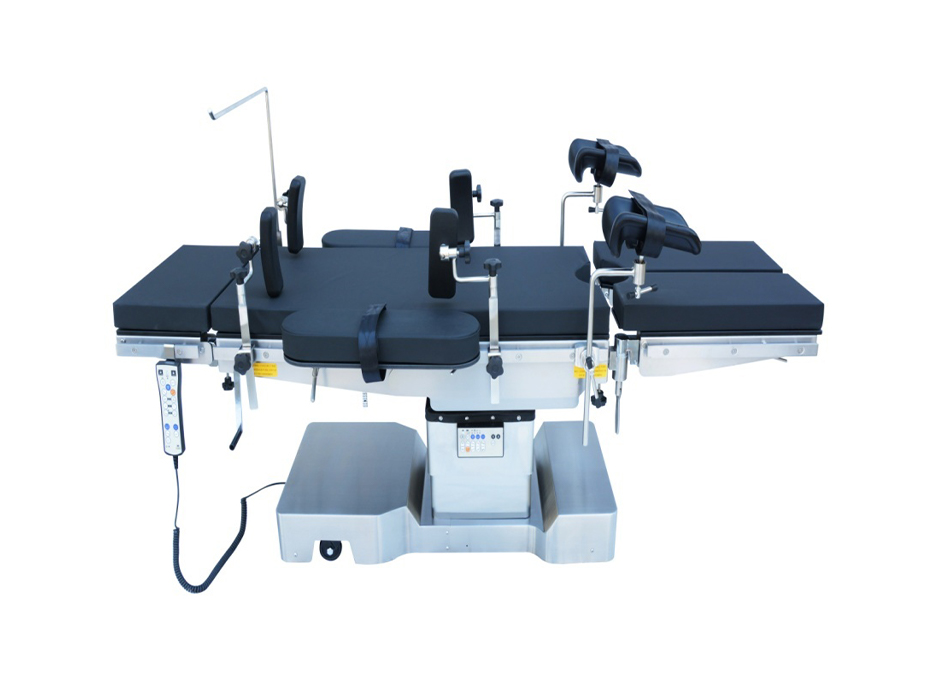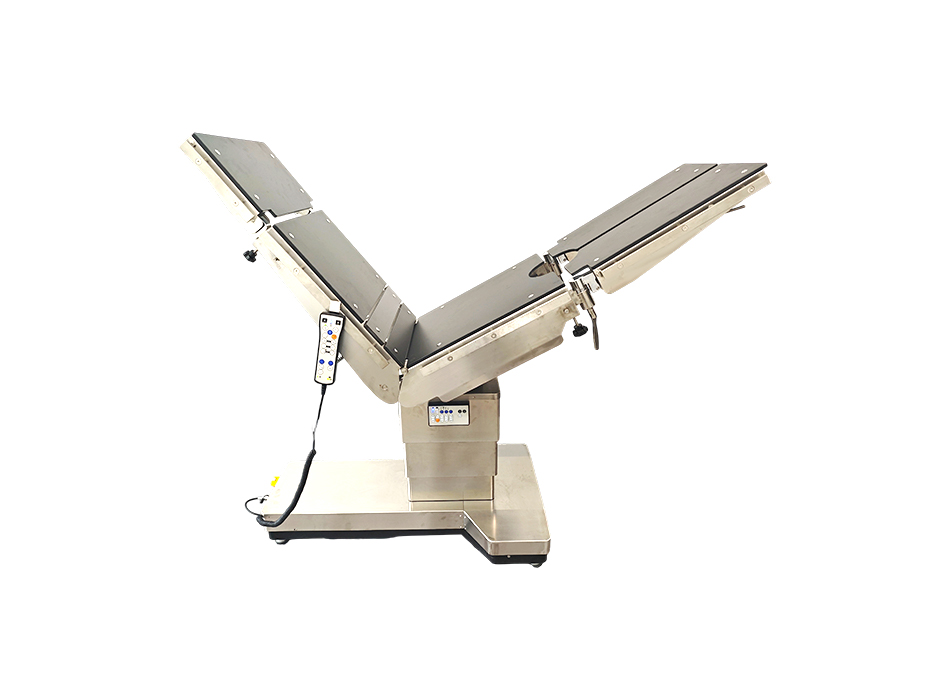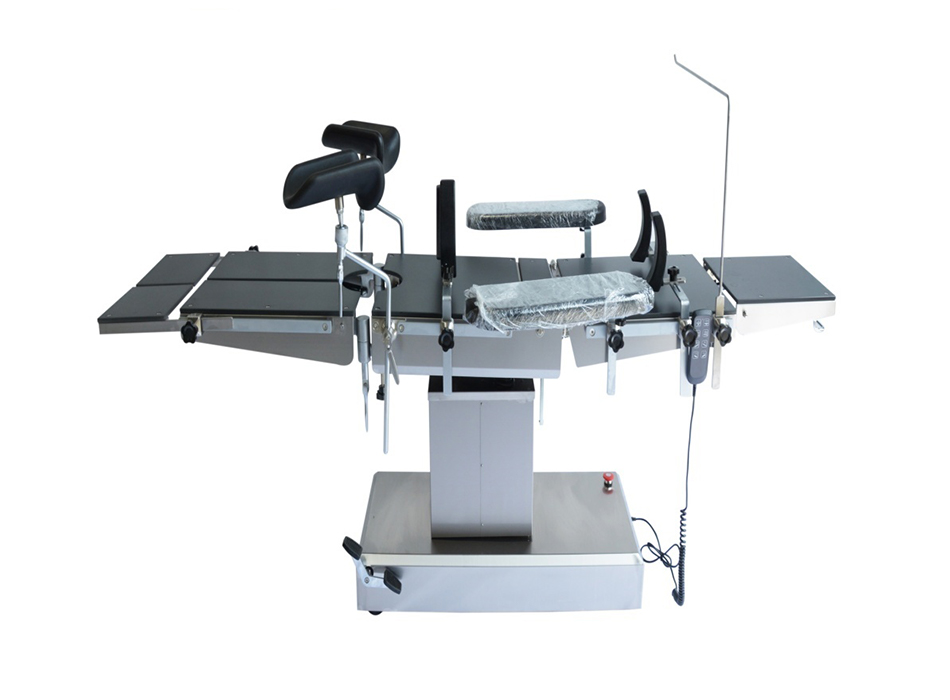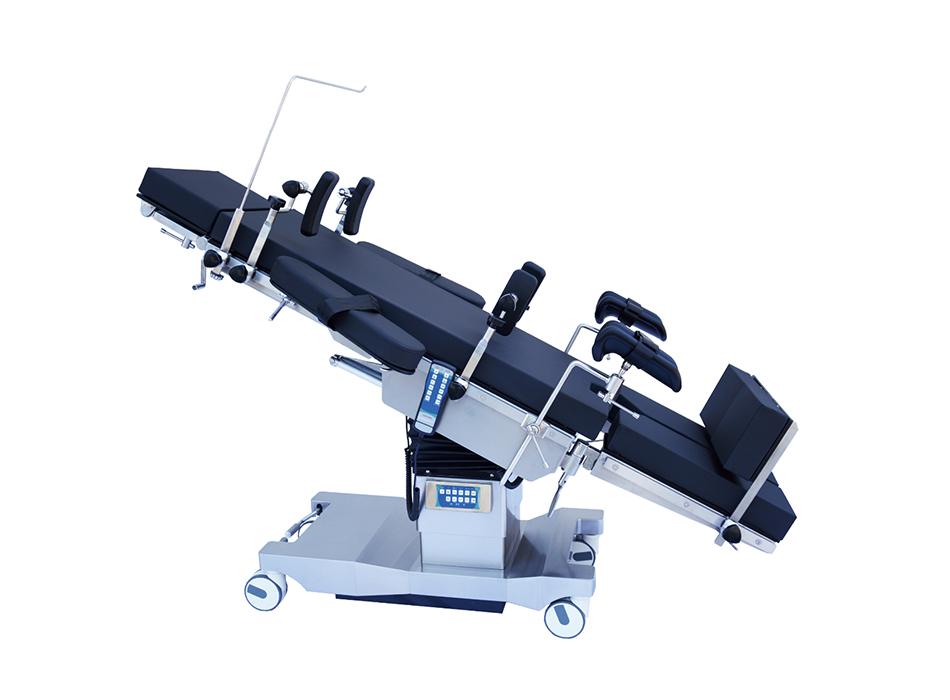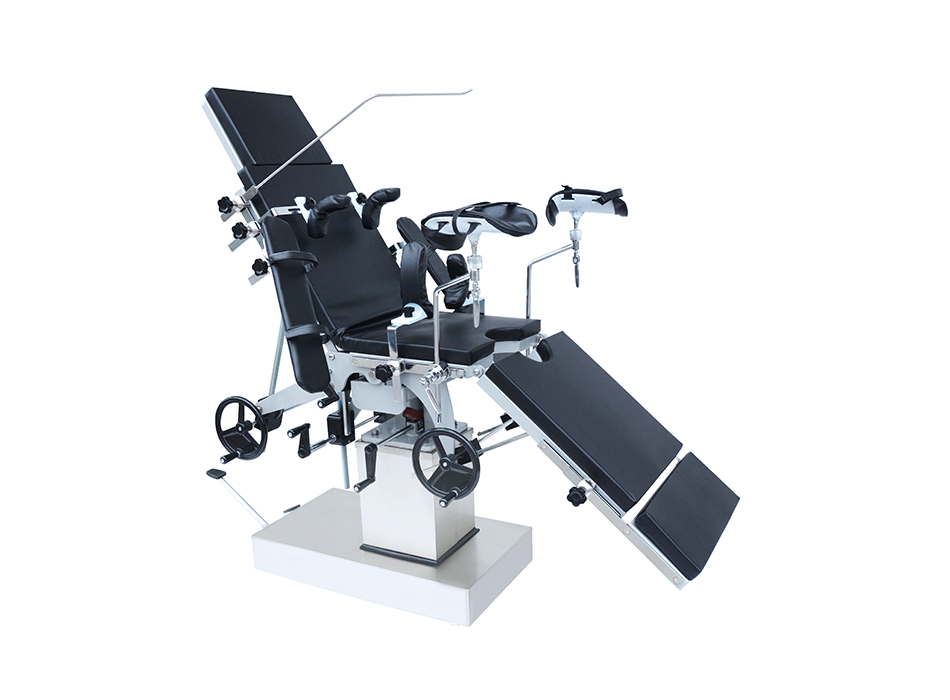 Welcome to Jiangsu Yigao Medical
Welcome to Jiangsu Yigao Medical
 E-MAIL:[email protected]
E-MAIL:[email protected]

Operation tables, also known as surgical tables or surgery tables, are fundamental equipment in operating rooms. They provide a stable platform for patients during surgical procedures and are designed to meet the diverse needs of different types of surgeries. A well-designed operating table not only offers stability but also enables precise patient positioning, which is essential for surgical accuracy and efficiency. Over the years, surgical tables have evolved significantly from simple manually adjustable platforms to highly advanced systems that integrate with other surgical equipment. This progression reflects the increasing complexity of surgical techniques and the demand for reliable solutions in patient care. Electro-hydraulic operation tables represent a significant step in this development, combining the reliability of hydraulic systems with the flexibility of electronic controls to enhance surgical performance and patient safety.
Electro-hydraulic technology integrates hydraulic power with electronic control systems to achieve smooth, precise, and efficient adjustments in surgical tables. In this design, hydraulic cylinders provide the necessary lifting and tilting force, while electronic controls ensure accurate operation with minimal manual effort. The result is a surgical table that offers seamless movement, stable positioning, and high adaptability across different surgical specialties. Compared to traditional manual or mechanical tables, electro-hydraulic operation tables minimize physical strain on medical staff and allow surgeons to adjust patient positioning with ease. This combination of hydraulic strength and electronic precision provides a reliable foundation for complex surgeries where patient positioning is critical.
The role of an electro-hydraulic operation table extends beyond simple patient support. It contributes directly to surgical efficiency, patient safety, and workflow optimization in the operating room. By offering a wide range of adjustable features such as height, tilt, lateral tilt, and Trendelenburg positions, these tables enable surgeons to achieve the most suitable surgical positioning. Additionally, their stability ensures that delicate surgical procedures can be carried out without unnecessary interruptions. For hospitals and surgical centers, investing in electro-hydraulic surgical tables means adopting equipment that aligns with the modern requirements of precision, adaptability, and operational reliability.
Electro-hydraulic surgical tables come equipped with a range of features designed to support both surgeons and patients. These features ensure that the table can be adjusted smoothly and securely during procedures. The following table summarizes some of the most common operation table features:
|
Feature |
Description |
Benefit in Surgery |
|
Height Adjustment |
Allows raising or lowering of the table electronically |
Enhances ergonomic comfort for surgeons |
|
Trendelenburg & Reverse Trendelenburg |
Tilts the table forward or backward |
Improves access to surgical sites |
|
Lateral Tilt |
Tilts the table to the left or right |
Facilitates specific surgical procedures |
|
Back and Leg Section Adjustments |
Supports flexible positioning of patient limbs |
Assists in specialized surgeries |
|
Remote or Foot Control |
Provides user-friendly adjustment controls |
Reduces manual effort for medical staff |
|
Battery Backup |
Ensures operation during power interruptions |
Maintains patient safety |
These features illustrate how electro-hydraulic systems support multiple surgical requirements while maintaining patient stability.
Electro-hydraulic operation tables provide multiple benefits to both patients and surgical teams. One major benefit is the ability to achieve precise patient positioning with minimal manual intervention. This reduces physical strain on surgical staff and allows them to focus on critical aspects of the procedure. The enhanced flexibility of movement also improves workflow efficiency, as adjustments can be made quickly without disrupting the surgical process. Another important benefit is patient comfort and safety. The stability of the hydraulic system reduces vibrations and sudden movements, ensuring that the patient remains secure throughout the operation. These benefits highlight why electro-hydraulic operating tables have become a preferred choice in modern surgical environments.
Patient positioning plays a vital role in surgical success. An electro-hydraulic operation table is specifically designed to support accurate positioning by providing smooth adjustments across different angles and sections. Proper positioning improves access to the surgical site, reduces the risk of complications, and ensures adequate exposure for the surgical team. For example, in abdominal surgeries, the Trendelenburg position allows better visualization of the operative area, while in orthopedic procedures, lateral tilt supports limb positioning. By allowing fine adjustments, electro-hydraulic tables improve surgical outcomes and contribute to safer patient management.
While traditional manual and mechanical surgical tables still exist in some healthcare settings, they have limitations compared to electro-hydraulic designs. Manual tables require physical effort to adjust, which can slow down surgical workflows and cause strain for medical staff. Mechanical systems, while offering some level of adjustment, may not provide the same precision or smoothness as hydraulic systems. Electro-hydraulic operation tables address these challenges by combining effortless electronic control with the strong support of hydraulic mechanisms. The following table provides a comparison:
|
Aspect |
Manual Tables |
Mechanical Tables |
Electro-Hydraulic Tables |
|
Adjustment Method |
Manual levers |
Mechanical cranks |
Electronic controls with hydraulic power |
|
Precision |
Limited |
Moderate |
High |
|
Staff Effort |
High |
Moderate |
Low |
|
Flexibility |
Basic |
Intermediate |
Advanced |
|
Suitability |
Low-complexity surgeries |
Moderate procedures |
Wide range of surgeries |
This comparison demonstrates why electro-hydraulic tables are increasingly favored in modern operating rooms.
Efficiency in the operating room depends not only on the surgical team but also on the equipment used. Electro-hydraulic operation tables support efficiency by minimizing the time spent on adjustments, enabling quicker patient preparation, and ensuring stable positioning throughout the procedure. Their adaptability reduces the need for multiple specialized tables, as one unit can serve various surgical specialties. In addition, features like remote control operation and memory functions further streamline processes, allowing surgical teams to focus on clinical tasks without unnecessary delays.
Like all surgical equipment, operating table maintenance is essential to ensure reliability and long service life. Electro-hydraulic surgical tables are designed with durability in mind, but regular maintenance is necessary to maintain performance. Maintenance practices typically include checking hydraulic fluid levels, inspecting electronic components, and verifying the smooth operation of all adjustment mechanisms. Preventive care reduces the risk of unexpected downtime and ensures patient safety during procedures. Hospitals often collaborate with surgical table manufacturers to establish scheduled maintenance plans and obtain spare parts when required. This proactive approach ensures that the electro-hydraulic system continues to perform effectively over time.
When selecting an electro-hydraulic operation table, hospitals must consider several factors such as surgical specialties, patient demographics, and budget. For facilities handling a wide variety of procedures, flexibility in patient positioning is particularly valuable. Weight capacity and table dimensions should also align with the expected patient population. Additionally, integration with other surgical equipment such as imaging devices or anesthesia systems may be an important consideration. By assessing these factors carefully, healthcare institutions can select an electro-hydraulic surgical table that supports their clinical needs while ensuring operational efficiency.
Recent years have witnessed ongoing advancements in electro-hydraulic surgical table design. Innovations include modular table tops that can be swapped depending on the surgical procedure, improved battery systems for uninterrupted performance, and enhanced safety mechanisms to prevent unintentional movement. Some models are also designed to integrate with digital surgical navigation systems, enabling synchronized positioning during minimally invasive procedures. These advances demonstrate the continuous efforts of surgical table manufacturers to improve both functionality and safety.
Looking ahead, the development of electro-hydraulic operation tables is likely to move toward greater integration with smart surgical technologies. Features such as automated positioning presets, data connectivity for operating room management systems, and improved ergonomic designs are expected to become more common. As robotic-assisted surgeries gain popularity, electro-hydraulic tables may also incorporate specialized interfaces to support robotic systems. These future trends indicate that surgical tables will continue to evolve as a key component of modern surgical equipment.
An electro-hydraulic operation table is an essential type of surgical table designed to provide flexibility, stability, and precision in the operating room. By integrating hydraulic power systems with electronic controls, this equipment enables smooth patient positioning and reliable operation during a wide range of surgical procedures. Unlike traditional operating tables, the electro-hydraulic design enhances surgical efficiency by allowing fine adjustments with minimal manual effort. Hospitals and surgical centers value these surgery tables for their ability to support complex procedures while ensuring patient comfort and safety. The features of these operation tables go beyond simple functionality; they are tailored to meet the requirements of modern surgical equipment and the increasing demands of healthcare facilities.
The tabletop of an electro-hydraulic operation table plays a crucial role in surgical positioning, ensuring that patients can be adjusted to optimal positions for different procedures. The system supports longitudinal shift, lateral tilt, height adjustment, and Trendelenburg as well as reverse Trendelenburg movements. These capabilities allow surgeons to obtain proper access to surgical sites while maintaining ergonomic working conditions. Longitudinal shift enables the patient to be moved along the table’s length without repositioning, which is especially beneficial in procedures involving imaging devices. Lateral tilt facilitates side-to-side adjustments for specific surgical needs, while height adjustment ensures comfort for both the surgical team and the patient. The Trendelenburg and reverse Trendelenburg positions provide flexibility in patient positioning to improve exposure to internal organs and support circulatory management during surgery.
|
Tabletop Movement |
Description |
Application in Surgery |
|
Longitudinal Shift |
Moves the tabletop forward and backward |
Enhances access during imaging and urology surgeries |
|
Lateral Tilt |
Tilts the table left or right |
Useful for thoracic and orthopedic procedures |
|
Height Adjustment |
Raises or lowers the entire table |
Provides ergonomic positioning for surgeons |
|
Trendelenburg |
Tilts the patient head-down |
Improves access in abdominal surgeries |
|
Reverse Trendelenburg |
Tilts the patient head-up |
Supports cardiovascular and ENT surgeries |
The variety of tabletop adjustments highlights how the electro-hydraulic system integrates multiple functions into a single operating table, improving surgical efficiency and supporting diverse clinical requirements.
Electro-hydraulic surgical tables incorporate advanced control systems that make adjustments quick and accurate. These control systems typically include handheld remote controls, foot pedals, and pre-programmed positions. Handheld remote controls provide intuitive access to adjustments, enabling surgeons or nurses to change patient positioning without interrupting the procedure. Foot pedals are often used for hands-free operation, maintaining sterile conditions in the operating room while ensuring patient positioning remains uninterrupted. Pre-programmed positions allow medical staff to recall commonly used configurations, streamlining preparation and reducing setup time.
|
Control System |
Function |
Benefit in Operating Room |
|
Handheld Remote |
Provides direct access to table adjustments |
Enhances convenience for staff |
|
Foot Pedals |
Enables hands-free operation |
Maintains sterility during surgery |
|
Pre-Programmed Positions |
Stores frequently used positions |
Improves surgical efficiency |
These control systems ensure that adjustments can be made swiftly and accurately, contributing to patient safety and surgical workflow optimization.
The materials used in constructing an electro-hydraulic operation table are chosen to meet both functional and safety standards in surgical environments. Stainless steel is commonly used for the table frame due to its durability, resistance to corrosion, and ease of cleaning. Radiolucent tabletop materials, often made from carbon fiber, are designed to support imaging procedures such as X-rays and C-arms without interfering with image quality. Antistatic pads are integrated into the tabletop surface to enhance patient safety by preventing static discharge in the operating room.
|
Material |
Purpose |
Relevance to Surgery |
|
Stainless Steel |
Provides strength and corrosion resistance |
Ensures long-term durability of surgical table |
|
Carbon Fiber |
Radiolucent for imaging compatibility |
Facilitates intraoperative imaging |
|
Antistatic Pads |
Prevents static electricity risks |
Protects both patient and equipment |
The thoughtful selection of construction materials ensures that electro-hydraulic surgical tables can withstand frequent use while maintaining safety and compatibility with other surgical equipment.
Safety is a primary concern in the design of every operating table, and electro-hydraulic models include multiple features to protect both patients and staff. Emergency stop mechanisms allow immediate halting of movement if unexpected issues occur, ensuring quick responses during critical moments. Weight capacity limits are built into the design to prevent overloading and ensure stable patient positioning, regardless of body size. Locking systems secure the table in place once adjustments are made, eliminating risks of unintentional movement during surgery.
|
Safety Feature |
Description |
Impact on Patient Safety |
|
Emergency Stop |
Immediately halts all table movement |
Ensures rapid response to unexpected events |
|
Weight Capacity Limit |
Prevents exceeding the maximum load |
Maintains stability for diverse patients |
|
Locking System |
Secures table sections and wheels |
Avoids unintended shifts during procedures |
By incorporating these safety mechanisms, electro-hydraulic operation tables provide reliability and reassurance in the operating room environment.
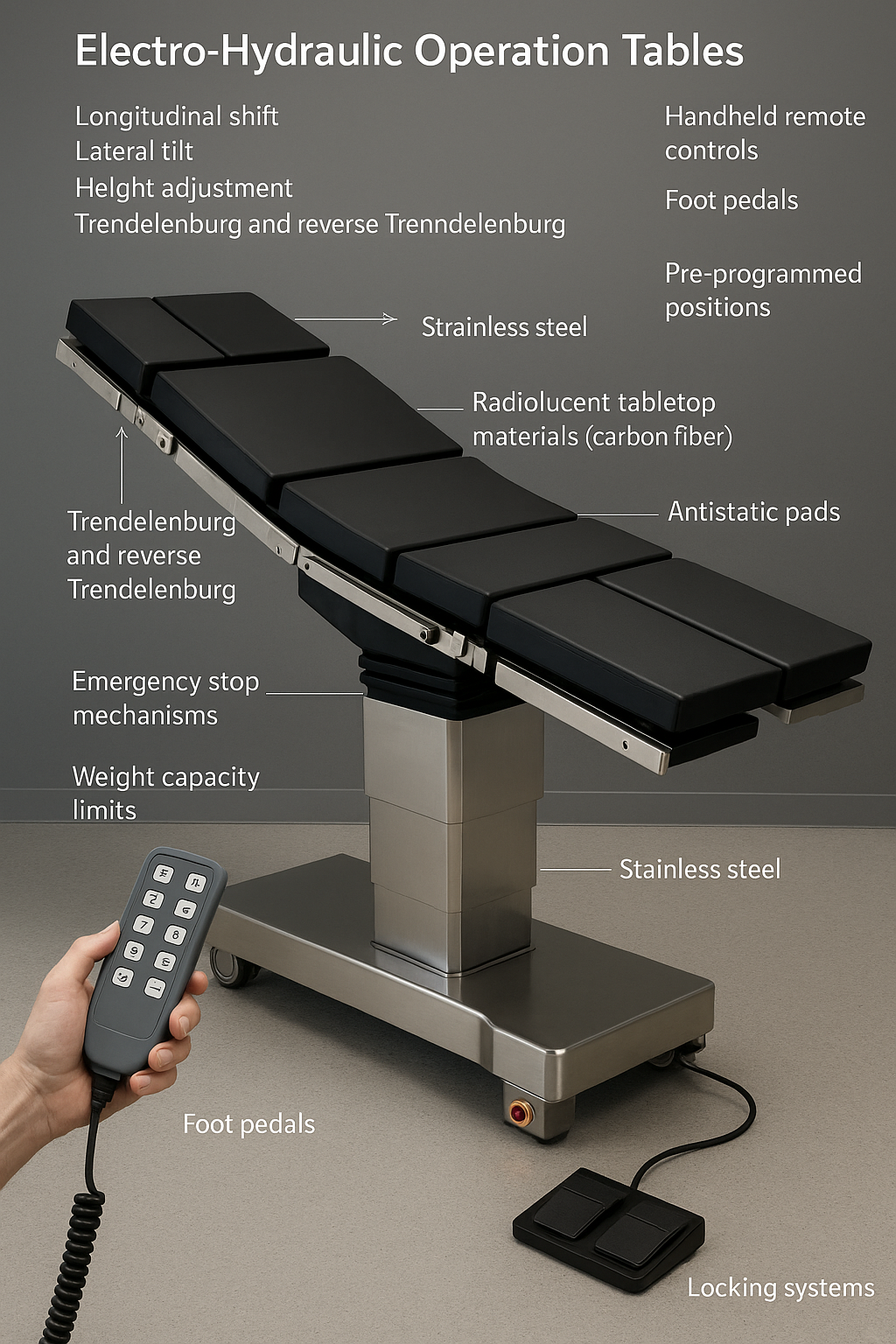
Electro-hydraulic surgical tables deliver benefits that extend beyond technical specifications. Their ability to provide accurate patient positioning reduces the physical strain on surgical staff, allowing them to work more efficiently. Improved surgical positioning also shortens preparation times and enhances overall workflow in the operating room. The integration of advanced hydraulic systems ensures smooth transitions, minimizing patient discomfort and improving safety during repositioning. These benefits contribute to a better surgical environment, where both efficiency and patient care are prioritized.
Modern operating rooms often require integration between the operating table and other surgical equipment such as anesthesia machines, imaging systems, or robotic-assisted devices. Electro-hydraulic tables are designed with compatibility in mind, ensuring that their features support seamless operation alongside these technologies. For example, radiolucent tabletops enable intraoperative imaging without transferring the patient, while modular sections allow adaptability to different specialties. This integration reduces workflow interruptions and maximizes the effectiveness of surgical procedures.
To maintain reliability, regular operating table maintenance is necessary. Electro-hydraulic operation tables require inspection of hydraulic fluid levels, checking of control systems, and verification of emergency features. Preventive maintenance minimizes downtime and ensures that the surgical table remains in optimal condition. Surgical table manufacturers often provide maintenance guidelines and support services to help healthcare facilities manage these requirements effectively. Hospitals benefit from implementing scheduled maintenance plans, which not only preserve equipment performance but also enhance patient safety.
The combination of tabletop flexibility, precise control systems, durable materials, and safety features makes electro-hydraulic surgical tables a valuable contributor to surgical efficiency. By reducing adjustment times, improving patient positioning, and integrating with other surgical equipment, these operating tables support smoother surgical workflows. Their adaptability means a single unit can be used across multiple surgical specialties, reducing the need for multiple types of surgery tables. This efficiency translates into better resource utilization and improved outcomes in the operating room.
Hospitals and surgical centers evaluating electro-hydraulic operation tables must consider factors such as patient population, surgical specialties, and available space in the operating room. Weight capacity, radiolucency, and ease of maintenance should also be assessed. Working closely with surgical table manufacturers ensures that the selected model aligns with clinical needs while meeting safety and efficiency standards. The decision to invest in this type of operating table should be based on a long-term perspective, recognizing its role as a critical component of surgical equipment.
The development of electro-hydraulic operating tables continues to advance, with trends pointing toward increased digital integration, smart sensors, and improved ergonomics. Future designs may incorporate automated patient positioning systems, data connectivity for surgical workflow monitoring, and enhanced battery performance to ensure uninterrupted operation. As surgical practices evolve, these innovations will further strengthen the role of electro-hydraulic surgical tables in modern healthcare environments.
An electro-hydraulic operation table is a type of surgical table that has become increasingly important in modern operating rooms. By combining hydraulic system strength with electronic precision, these surgery tables provide features that enhance patient positioning, improve workflow, and support surgical efficiency. Unlike earlier models that relied heavily on manual adjustments, electro-hydraulic designs integrate advanced operation table features such as remote-controlled positioning, smooth movement, and safety mechanisms. For hospitals and surgical centers, understanding the operation table benefits is crucial when making decisions about surgical equipment. This article examines the specific advantages of electro-hydraulic operation tables, focusing on precision, efficiency, ergonomics, and patient safety.
One of the key benefits of an electro-hydraulic operation table is its ability to deliver enhanced precision and control during surgical procedures. Accurate surgical positioning is vital for both patient safety and procedural success, and electro-hydraulic designs make this possible through fine adjustments in multiple directions. These tables allow surgeons to position patients longitudinally, laterally, or at specific angles such as Trendelenburg and reverse Trendelenburg. The hydraulic system provides stable support, ensuring that the patient remains securely positioned without unwanted shifts.
|
Precision Feature |
Description |
Impact on Surgery |
|
Multi-Axis Adjustment |
Supports height, tilt, and lateral movement |
Provides precise patient positioning |
|
Hydraulic Stability |
Maintains secure patient placement |
Reduces risks of movement during delicate procedures |
|
Remote-Controlled Operation |
Enables fine adjustments without manual effort |
Improves accuracy and workflow |
With these features, electro-hydraulic surgical tables ensure that surgeons can focus on the procedure without worrying about repositioning challenges, thus increasing the overall reliability of the operating room environment.
Surgical efficiency is closely tied to how quickly and smoothly adjustments can be made during operations. Electro-hydraulic operation tables are designed to facilitate efficiency by allowing quick, effortless modifications to patient positioning. Remote controls and foot pedals enable medical staff to make adjustments within seconds, minimizing interruptions and reducing surgery time. In many cases, shortened operating times contribute to better outcomes, as patients spend less time under anesthesia. Additionally, these operating tables often have memory functions that allow frequently used positions to be programmed and recalled instantly.
|
Efficiency Factor |
Description |
Benefit to Operating Room |
|
Quick Adjustments |
Rapid changes in patient positioning |
Minimizes delays during procedures |
|
Pre-Programmed Positions |
Stores commonly used settings |
Reduces preparation time |
|
Reduced Manual Effort |
Less reliance on physical adjustments |
Improves workflow for surgical staff |
By enhancing efficiency, electro-hydraulic surgery tables support smoother coordination in the operating room and enable surgical teams to concentrate on critical tasks.
Another important benefit of electro-hydraulic surgical tables is their ability to support ergonomic working conditions for surgeons. During lengthy operations, physical strain can affect surgical performance and staff well-being. An electro-hydraulic operating table helps address this by allowing precise adjustments to height and angle, ensuring that surgeons can maintain comfortable working postures. Proper ergonomic positioning also provides better access to the surgical site, reducing fatigue and enhancing focus.
|
Ergonomic Feature |
Description |
Impact on Surgeons |
|
Adjustable Height |
Aligns table with surgeon’s comfort level |
Reduces strain on back and shoulders |
|
Tilt and Lateral Movement |
Provides optimal access angles |
Improves surgical accuracy |
|
Stable Platform |
Maintains steady positioning |
Minimizes fatigue during extended surgeries |
These ergonomic advantages are not only beneficial to surgeons but also to the entire operating team, as they create a safer and more effective surgical environment.
Patient safety is a primary consideration in every surgical procedure, and the electro-hydraulic operation table contributes significantly in this area. The hydraulic system ensures even weight distribution, reducing pressure points and minimizing the risk of complications. Comfortable padding and antistatic materials enhance the patient experience, particularly during lengthy operations. Additionally, safety mechanisms such as locking systems and emergency stop functions provide reassurance that patients remain secure throughout the procedure.
|
Safety and Comfort Feature |
Description |
Impact on Patient Care |
|
Even Weight Distribution |
Prevents excessive pressure on specific areas |
Enhances comfort during long surgeries |
|
Comfortable Padding |
Provides cushioning and support |
Reduces patient discomfort |
|
Safety Locks and Emergency Stops |
Prevents unintended movement |
Ensures stable and secure placement |
By combining comfort with safety features, electro-hydraulic operation tables create an environment where patients are protected while receiving the care they need.
From a broader perspective, the benefits of electro-hydraulic surgical tables extend beyond the operating room. For hospitals and clinics, these operation tables represent an investment in both efficiency and patient care. Their versatility allows one table to serve multiple surgical specialties, reducing the need for multiple types of surgical equipment. Their durability and ease of operation table maintenance ensure long-term reliability, making them cost-effective solutions for healthcare facilities. Surgical table manufacturers design these models to meet a wide range of clinical demands, helping healthcare providers achieve better outcomes while managing resources effectively.
When comparing electro-hydraulic operation tables with manual or mechanical models, the differences in benefits are clear. Manual tables require significant physical effort for adjustments, which can slow down workflow and cause staff fatigue. Mechanical tables offer some improvements but often lack the precision and efficiency provided by electro-hydraulic systems. The integration of hydraulic systems and electronic controls in electro-hydraulic tables creates a balance between strength and precision that traditional models cannot match.
|
Aspect |
Manual Operating Table |
Mechanical Operating Table |
Electro-Hydraulic Operating Table |
|
Adjustment Method |
Manual levers |
Cranks and gears |
Electronic remote with hydraulic power |
|
Precision |
Limited |
Moderate |
High |
|
Staff Effort |
High |
Moderate |
Low |
|
Patient Positioning |
Basic |
Intermediate |
Advanced |
|
Efficiency |
Limited |
Improved |
High |
This comparison highlights why healthcare providers increasingly prefer electro-hydraulic surgical tables when upgrading surgical equipment.
Electro-hydraulic operating tables are versatile enough to be used in a wide range of surgical specialties, from general surgery to orthopedics and cardiovascular procedures. Their ability to accommodate specific surgical positioning requirements ensures that they meet diverse clinical needs. For example, lateral tilt may be essential in thoracic surgeries, while Trendelenburg positioning is commonly required in abdominal operations. The adaptability of these surgery tables allows hospitals to maximize their resources without compromising surgical efficiency.
Operation table maintenance is an important factor in sustaining the benefits of electro-hydraulic designs. Regular inspections of the hydraulic system, electronic controls, and safety mechanisms help ensure reliable performance. With proper care, these tables can provide many years of service, supporting multiple surgical specialties. Surgical table manufacturers often supply detailed maintenance schedules and replacement parts, allowing healthcare facilities to manage upkeep efficiently. This reliability makes electro-hydraulic operating tables a sustainable choice for long-term surgical equipment investments.
The future of electro-hydraulic operation tables is expected to include further improvements in technology and design. Integration with digital systems, automated positioning, and compatibility with robotic-assisted surgeries are trends that will continue to enhance their benefits. These innovations will contribute to greater surgical efficiency, improved ergonomics, and higher levels of patient safety. As surgical practices evolve, electro-hydraulic surgical tables will remain central to the development of modern operating rooms.
An electro-hydraulic operation table is a vital piece of surgical equipment in modern operating rooms. By combining the strength of hydraulic systems with the precision of electronic controls, these surgical tables allow for smooth patient positioning and reliable functionality across different surgical specialties. The operating table is not just a platform for supporting patients but a critical component that directly affects surgical efficiency, patient safety, and the workflow of medical staff. As surgical demands grow more complex, the need for specialized electro-hydraulic operating tables becomes increasingly important. These tables are manufactured in various types to meet the requirements of general surgery, specialized procedures, and bariatric care. Understanding the differences between these models helps hospitals and clinics make informed decisions when selecting surgical tables that align with their clinical needs.
General surgery electro-hydraulic operation tables are designed for versatility, making them suitable for a broad range of procedures. These surgery tables typically offer adjustable height, Trendelenburg and reverse Trendelenburg positions, lateral tilt, and longitudinal shift. Such operation table features enable surgeons to perform diverse surgeries, from abdominal operations to ENT procedures, with appropriate patient positioning. The design of general surgery tables emphasizes adaptability, allowing one table to support multiple specialties within the operating room. Hospitals often rely on these models when they require multifunctional surgical equipment that can accommodate routine and emergency surgeries alike.
|
Feature |
Description |
Application |
|
Height Adjustment |
Raises or lowers the patient platform |
Provides ergonomic access for surgeons |
|
Trendelenburg & Reverse |
Tilts patient head-down or head-up |
Supports abdominal and cardiovascular surgeries |
|
Lateral Tilt |
Side-to-side adjustments |
Enhances positioning for thoracic procedures |
|
Longitudinal Shift |
Moves patient along table length |
Useful for imaging and urology procedures |
The benefits of general surgery electro-hydraulic operation tables include flexibility, efficiency in patient positioning, and suitability for hospitals with varied surgical requirements.
Specialty electro-hydraulic operation tables are designed with features tailored to specific surgical disciplines. Unlike general surgery tables, these models integrate specialized configurations and accessories that meet the unique demands of orthopedic, neurological, urological, and cardiac procedures.
Orthopedic surgical tables are structured to accommodate limb positioning, traction systems, and radiolucent tabletops for imaging compatibility. They often feature detachable components that allow precise surgical positioning during joint replacements, spinal surgeries, and fracture repairs. The hydraulic system provides stability during traction, ensuring patient safety and consistent results.
Neurological operating tables require precision and stability above all else. These electro-hydraulic tables are designed to support delicate procedures involving the brain and spinal cord. Features may include advanced headrest supports, fine tilt adjustments, and compatibility with neurosurgical navigation systems. By allowing exact patient positioning, these tables reduce risks during highly sensitive operations.
Urological surgical tables are designed for procedures involving the urinary tract, kidneys, and bladder. These tables often incorporate radiolucent tabletops for intraoperative imaging and longitudinal shift for access during endoscopic procedures. Adjustable leg supports and cutout sections provide surgeons with the flexibility required for minimally invasive urology surgeries.
Cardiac operating tables focus on providing stability and optimal positioning for open-heart and cardiovascular surgeries. Features may include extreme Trendelenburg positioning, compatibility with heart-lung machines, and robust weight capacities. These electro-hydraulic operation tables are crucial for ensuring proper patient positioning and supporting the complexity of cardiac interventions.
|
Specialty Table Type |
Key Features |
Clinical Application |
|
Orthopedic |
Traction systems, detachable parts, radiolucency |
Joint replacement, spinal surgeries |
|
Neurological |
Advanced headrests, fine tilt adjustments |
Brain and spinal cord procedures |
|
Urological |
Longitudinal shift, radiolucent surfaces, leg supports |
Endoscopic and urology surgeries |
|
Cardiac |
High stability, extreme tilt positions |
Cardiovascular and open-heart surgeries |
The variety of specialty tables highlights how electro-hydraulic operation tables can be customized to meet the demands of complex surgical procedures.
Bariatric electro-hydraulic operation tables are designed specifically for patients with higher body weights. These operating tables feature reinforced frames, hydraulic systems capable of supporting high loads, and wider tabletops to ensure even weight distribution. Bariatric tables must balance patient comfort with safety, ensuring that positioning adjustments remain smooth despite the increased load.
|
Feature |
Description |
Benefit |
|
High Weight Capacity |
Supports significantly higher patient loads |
Ensures patient safety during bariatric surgery |
|
Wider Tabletop |
Provides greater surface area |
Enhances patient comfort and stability |
|
Reinforced Hydraulic System |
Stronger hydraulic support |
Maintains smooth adjustments under heavy load |
Bariatric surgery tables are essential for hospitals that treat patients requiring obesity-related procedures or general surgeries on larger body types. Their construction ensures that patient positioning is secure and reliable, supporting both safety and surgical efficiency.
Although each type of electro-hydraulic operation table has specific features, they all share common benefits. These include precise surgical positioning, enhanced safety mechanisms, and improved workflow efficiency in the operating room. General surgery tables provide adaptability, specialty tables meet unique clinical requirements, and bariatric tables address the challenges of treating patients with higher body weights. Collectively, these surgical tables ensure that hospitals can meet diverse surgical demands with reliable equipment.
|
Table Type |
Primary Benefit |
Example of Use |
|
General Surgery Table |
Versatility for multiple procedures |
Abdominal and ENT surgeries |
|
Specialty Table |
Tailored to specific disciplines |
Orthopedic or neurosurgical procedures |
|
Bariatric Table |
High capacity and stability |
Obesity-related surgeries |
This comparison demonstrates how different electro-hydraulic surgery tables contribute to surgical efficiency while addressing patient-specific needs.
When choosing an electro-hydraulic operating table, hospitals and surgical centers must consider factors such as patient demographics, surgical specialties, and operating room space. Weight capacity, radiolucency, and compatibility with imaging equipment are important operation table features that influence decision-making. Operation table maintenance requirements should also be taken into account, as regular care ensures long-term reliability. By consulting with surgical table manufacturers, healthcare facilities can identify models that balance clinical demands with budgetary considerations.
All types of electro-hydraulic surgical tables require consistent maintenance to sustain performance. Preventive practices include inspecting hydraulic systems, checking control units, and ensuring that safety features function correctly. Hospitals often work with surgical table manufacturers to establish maintenance schedules that align with the usage intensity of each table type. Regular operation table maintenance ensures that these valuable pieces of surgical equipment remain safe and efficient over time.
The role of electro-hydraulic operation tables extends to overall surgical efficiency. Their smooth patient positioning and specialized designs reduce preparation times, minimize staff workload, and support better surgical outcomes. Whether in general surgery, specialized disciplines, or bariatric procedures, the use of these surgery tables allows hospitals to deliver care more effectively. The integration of advanced hydraulic systems with electronic controls ensures that these tables remain central to the workflow of any modern operating room.
The future of electro-hydraulic operating tables points toward increased specialization and digital integration. Innovations may include automated positioning systems, enhanced compatibility with robotic-assisted surgery, and modular designs that allow quick reconfiguration for different procedures. These advancements will further expand the operation table benefits across all types, ensuring that surgical teams can meet evolving clinical challenges with efficiency and precision.
An electro-hydraulic operation table is a fundamental component of any modern operating room. These surgical tables combine a hydraulic system for strength and stability with electronic controls for precision. The operating table supports patient positioning, ensures comfort, and provides surgeons with ergonomic access during procedures. Because surgical demands vary widely depending on specialty, patient needs, and institutional resources, careful consideration must be given when selecting an electro-hydraulic surgery table. Hospitals and clinics must evaluate different operation table features and benefits to ensure that the chosen model aligns with both clinical goals and long-term usability.
One of the primary factors in selecting an electro-hydraulic operation table is the surgical specialty of the healthcare facility. General surgery tables are designed to handle a wide range of procedures, while specialty tables are tailored to disciplines such as orthopedics, neurology, urology, or cardiology. For example, orthopedic surgical tables often include traction systems and detachable components, while neurological tables prioritize micro-adjustments and stability. A surgery table used for cardiac operations must support steep Trendelenburg positioning and integration with cardiovascular equipment. Matching the operating table to the surgical specialty ensures efficiency, patient safety, and compatibility with required surgical equipment.
|
Surgical Specialty |
Table Features |
Benefits |
|
General Surgery |
Height adjustment, Trendelenburg, lateral tilt |
Versatility across multiple procedures |
|
Orthopedic |
Traction system, radiolucent tabletop |
Supports joint replacements, fracture repair |
|
Neurological |
Fine tilt adjustments, headrest supports |
Precision in delicate brain and spinal operations |
|
Urological |
Longitudinal shift, imaging compatibility |
Facilitates endoscopic and urological procedures |
|
Cardiac |
Extreme tilt options, stable support |
Enhances cardiovascular surgery access |
By identifying the exact surgical specialties served, hospitals can select electro-hydraulic operation tables that enhance surgical efficiency and reduce the need for multiple specialized platforms.
Another important factor is the weight capacity of the surgical table. Electro-hydraulic operation tables are engineered to support patients of varying body types, but not all models are designed for bariatric use. For facilities treating a diverse patient population, bariatric tables with higher weight limits and wider tabletops may be necessary. A standard operating table may support most patients, but when patient safety is at risk, weight capacity becomes a critical element of decision-making. Ensuring proper weight support also protects the hydraulic system from strain, extending the table’s service life.
|
Table Type |
Standard Weight Capacity |
Bariatric Weight Capacity |
|
General Surgery Table |
200–250 kg |
Not suitable for high-weight patients |
|
Bariatric Surgery Table |
350–450 kg |
Designed for larger patients |
|
Specialty Tables |
200–250 kg |
Dependent on surgical discipline |
By selecting an operating table with the correct weight capacity, facilities ensure reliable patient positioning and reduce the risk of technical malfunctions during surgery.
Tabletop adjustability is central to the function of an electro-hydraulic operation table. A wide range of motion allows surgeons to position patients for optimal access while maintaining patient comfort. Common adjustments include height control, Trendelenburg and reverse Trendelenburg positions, lateral tilt, and longitudinal shift. These surgical positioning features are essential for creating ideal operating conditions. For example, longitudinal shift helps align patients with imaging devices, while lateral tilt supports thoracic and abdominal surgeries.
|
Adjustment Option |
Purpose |
Example of Use |
|
Height Adjustment |
Provides ergonomic surgeon access |
Standard across all surgeries |
|
Trendelenburg |
Tilts patient head-down |
Abdominal or gynecological procedures |
|
Reverse Trendelenburg |
Tilts patient head-up |
Cardiovascular or ENT surgeries |
|
Lateral Tilt |
Side-to-side positioning |
Thoracic or spine surgeries |
|
Longitudinal Shift |
Moves patient lengthwise |
Urology or imaging-guided operations |
The flexibility of tabletop adjustability increases the operation table benefits for both patients and surgeons, ensuring surgical efficiency and safety across multiple procedures.
The control system of an electro-hydraulic operation table determines how effectively surgical staff can operate it. Ergonomic controls allow quick, precise, and intuitive adjustments, which directly influence surgical efficiency. Modern surgery tables often include handheld remote controls, footswitches, or integrated touch panels. These systems allow surgeons or assistants to adjust the table without interrupting the procedure. Accessibility is also important, as control panels must be positioned conveniently and designed for easy sterilization.
|
Control Type |
Description |
Advantage |
|
Handheld Remote |
Portable control unit with buttons |
Convenient and precise adjustments |
|
Footswitch |
Hands-free control option |
Allows surgeons to adjust without stopping |
|
Touch Panel |
Integrated screen with advanced settings |
Supports complex surgical positioning |
Hospitals must evaluate control system ergonomics to ensure that the electro-hydraulic operation table enhances workflow rather than adding complexity to the operating room environment.
While performance and flexibility are essential, patient safety and comfort remain critical. An operating table must provide even weight distribution, stable support, and comfortable padding. These features reduce the risk of pressure injuries and enhance patient outcomes during long surgical procedures. Safety rails, locking mechanisms, and emergency manual overrides are also essential operation table features that prevent accidents in the operating room. Patient positioning should be smooth and stable, preventing sudden movements that could disrupt surgery.
Electro-hydraulic tables with customizable padding and modular accessories further enhance comfort. For bariatric or orthopedic surgeries, the ability to adjust leg and arm supports ensures better patient care.
Another factor to consider when choosing an electro-hydraulic operation table is long-term reliability and ease of maintenance. Surgical equipment in the operating room is subject to frequent use, and maintaining functionality requires regular inspections. Hydraulic systems should be checked for leaks, electronic controls for responsiveness, and all moving parts for wear. Surgical table manufacturers often provide recommended maintenance schedules and service agreements to ensure tables remain operational.
|
Maintenance Task |
Frequency |
Purpose |
|
Hydraulic System Check |
Monthly |
Ensures no leaks and smooth adjustments |
|
Control System Test |
Weekly |
Confirms remote or panel responsiveness |
|
Padding Inspection |
After each procedure |
Maintains patient comfort and hygiene |
|
Annual Professional Service |
Yearly |
Extends table lifespan and reliability |
By integrating preventive operation table maintenance into hospital routines, facilities safeguard both patient safety and surgical efficiency.
Choosing the right electro-hydraulic operating table also depends on collaboration with surgical table manufacturers. Experienced manufacturers provide guidance on operation table features, customization options, and long-term service support. They may also offer training programs for staff to ensure proper use of the equipment. By working directly with manufacturers, hospitals can identify models tailored to their specific surgical requirements and gain access to parts and maintenance resources that extend the life of their surgical tables.
Each factor—whether surgical specialty, weight capacity, adjustability, control ergonomics, or maintenance—ultimately contributes to surgical efficiency. A well-chosen electro-hydraulic surgery table reduces setup time, improves surgical positioning, and ensures reliable patient support. When combined, these benefits create a smoother workflow in the operating room, enabling surgeons to focus on procedures while minimizing risks for both patients and staff.
